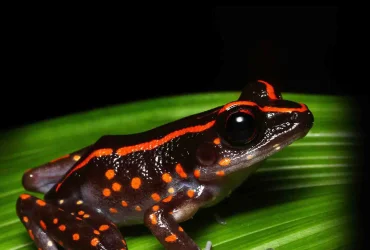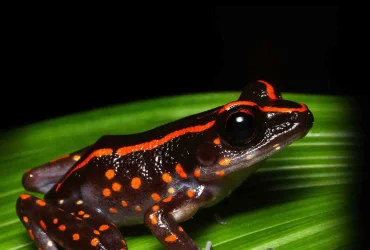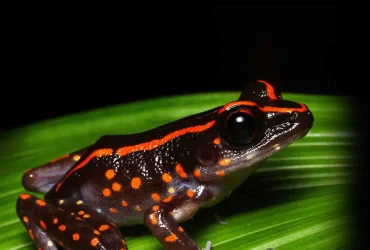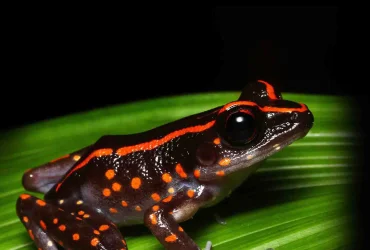Volume 9-14 (2020-26)
 v14i2.370
v14i2.370eISSN: 1800-427X (online)
DOI:10.47605/tapro.v14i2.370
Submitted date: 7 December 2024
Accepted date: 22 June 2025
Published date: 21 August 2025
Pp. 180–187.
SPECIES RICHNESS, ENDEMISM AND BIOGEOGRAPHY OF FRESH WATER DIATOMS (OCHROPHYTA: BACILLARIOPHYCEAE) FROM INDONESIA: A REVIEW
Ni Made D. Swastiki, Dian Hendrayanti* & J. Patrick Kociolek
*Corresponding author. E-mail: dian.hendrayanti@sci.ui.ac.id
Abstract
We present the first cumulative list of freshwater diatoms from Indonesia, encompassing literature extending from 1865 until 2023. A total of 1160 names have been published. With a consideration of homotypic synonyms, the total number of different freshwater diatom taxa reported from Indonesia is over 1050. Genera with the largest number of reported species include Nitzschia (94), Cymbella sensu lato (73), Eunotia (72), Pinnularia (67), Surirella (60), and Gomphonema (48). There are two genera endemic to Indonesian freshwaters, namely Alveocymba and Celebesia, while all but one species of Tetralunata are endemic. Over 30% of the reported taxa are endemic to Indonesia. The flora of Indonesia is similar in size to that reported for all of Europe. The reported freshwater diatom flora of Indonesia, with the desmid flora, when combined, surpasses the number of all other algae reported for Indonesia.
Section Editor: David Williams
DOI:10.47605/tapro.v14i2.370
Submitted date: 7 December 2024
Accepted date: 22 June 2025
Published date: 21 August 2025
Pp. 180–187.
SPECIES RICHNESS, ENDEMISM AND BIOGEOGRAPHY OF FRESH WATER DIATOMS (OCHROPHYTA: BACILLARIOPHYCEAE) FROM INDONESIA: A REVIEW
Ni Made D. Swastiki, Dian Hendrayanti* & J. Patrick Kociolek
*Corresponding author. E-mail: dian.hendrayanti@sci.ui.ac.id
Abstract
We present the first cumulative list of freshwater diatoms from Indonesia, encompassing literature extending from 1865 until 2023. A total of 1160 names have been published. With a consideration of homotypic synonyms, the total number of different freshwater diatom taxa reported from Indonesia is over 1050. Genera with the largest number of reported species include Nitzschia (94), Cymbella sensu lato (73), Eunotia (72), Pinnularia (67), Surirella (60), and Gomphonema (48). There are two genera endemic to Indonesian freshwaters, namely Alveocymba and Celebesia, while all but one species of Tetralunata are endemic. Over 30% of the reported taxa are endemic to Indonesia. The flora of Indonesia is similar in size to that reported for all of Europe. The reported freshwater diatom flora of Indonesia, with the desmid flora, when combined, surpasses the number of all other algae reported for Indonesia.
Section Editor: David Williams
 v14i2.369
v14i2.369eISSN: 1800-427X (online)
DOI:10.47605/tapro.v14i2.369
Submitted date: 24 August 2024
Accepted date: 22 June 2025
Published date: 21 August 2025
Pp. 174–179.
A GEOSPATIAL APPROACH TO THE DISTRIBUTION, DENSITY, AND HOTSPOTS OF FRESHWATER CRABS (DECAPODA: GECARCINUCIDAE) IN SRI LANKA
Dinesh Gabadage, Tharana I. Laksith*, Sachini K. Dissanayake, Lakna S. Elvitigala & G.M. Edirihinghe
*Corresponding author. E-mail: tharanainu@gmail.com
Abstract
Sri Lanka harbors a notable diversity of freshwater crab species. 50 endemic species out of 51 described species in seven genera are found in Sri Lanka. In this study, freshwater crab distribution, densities, and hotspots were identified using geospatial techniques with a collection of data consisting of field surveys and available literature from 1960 to the present. The distribution of freshwater crabs shows distinctive patterns across the country, with spatial distribution clustered in the wet zone. Genus Oziothelphusa exhibited a widespread distribution over Sri Lanka. Density maps reveal high-density clusters in the wet zone, exhibiting a preference by crabs for wetter conditions. Ultimately, the hotspot analysis revealed that the central highlands, southwestern, and western lowlands of the wet zone of the country are the hotspots for freshwater crabs with 99% confidence. The results emphasize the importance of prioritizing conservation plans for the long-term survival of freshwater crabs in Sri Lanka.
Section Editor: Seth J. Wenger
DOI:10.47605/tapro.v14i2.369
Submitted date: 24 August 2024
Accepted date: 22 June 2025
Published date: 21 August 2025
Pp. 174–179.
A GEOSPATIAL APPROACH TO THE DISTRIBUTION, DENSITY, AND HOTSPOTS OF FRESHWATER CRABS (DECAPODA: GECARCINUCIDAE) IN SRI LANKA
Dinesh Gabadage, Tharana I. Laksith*, Sachini K. Dissanayake, Lakna S. Elvitigala & G.M. Edirihinghe
*Corresponding author. E-mail: tharanainu@gmail.com
Abstract
Sri Lanka harbors a notable diversity of freshwater crab species. 50 endemic species out of 51 described species in seven genera are found in Sri Lanka. In this study, freshwater crab distribution, densities, and hotspots were identified using geospatial techniques with a collection of data consisting of field surveys and available literature from 1960 to the present. The distribution of freshwater crabs shows distinctive patterns across the country, with spatial distribution clustered in the wet zone. Genus Oziothelphusa exhibited a widespread distribution over Sri Lanka. Density maps reveal high-density clusters in the wet zone, exhibiting a preference by crabs for wetter conditions. Ultimately, the hotspot analysis revealed that the central highlands, southwestern, and western lowlands of the wet zone of the country are the hotspots for freshwater crabs with 99% confidence. The results emphasize the importance of prioritizing conservation plans for the long-term survival of freshwater crabs in Sri Lanka.
Section Editor: Seth J. Wenger
 v14i2.368
v14i2.368eISSN: 1800-427X (online)
DOI:10.47605/tapro.v14i2.368
Submitted date: 11 May 2024
Accepted date: 25 July 2025
Published date: 21 August 2025
Pp. 166–173.
ECOLOGICAL RISK ANALYSIS OF HARMFUL ALGAL BLOOMS (HABS) IN BIMA BAY, WEST NUSA TENGGARA, INDONESIA
J. Jalaludin*, S. Suharyanto, Barti S. Muntalif & Prayatni Soewondo
*Corresponding author. E-mail: jalaludinakins@gmail.com
Abstract
In April 2022, the occurrence of Harmful Algal Blooms (HABs) was first reported in Bima Bay, West Nusa Tenggara, resulting in a mass fish mortality event and the formation of a brown gel-like biomass that covered a significant portion of the Amahami coastal area. Here, we assess the extent of pollution and its associated ecological risk in the aquatic environment of Bima Bay. The assessment is conducted through two scenarios: 1) the vulnerability of the bay and the potential occurrence of HABs and associated pollutant load index (PLI) and water quality index (WQI); 2) the potential ecological impact of HABs related to the structure of the phytoplankton community. The PLI calculation at all stations exceeded 1, indicating an increase in environmental pollution. The pollution index (PI) at eleven stations was classified as moderately polluted, and one station was classified as lightly polluted, with a WQI of 31.67 or in the poor water quality category. Phytoplankton abundance in Bima Bay ranged from 811 – 854,724 individuals/liter. The five most dominant phytoplankton species were identified as Pseudonitzschia sp., Chaetoceros spp., Lauderia spp., Rhizosolenia spp., and Chatonella sp. The level of HAB risk in different areas of Bima Bay is based on the PI value and the proportion of the highest toxic species obtained at stations 2 and 1, with PI values of 5.83 and 5.60, and toxic proportions of 0.41 and 0.38. The distribution of HAB tends to be concentrated in the inner bay, particularly on the east and south coasts. The potential for phytoplankton blooming is relatively higher during the months of the rainy season, as indicated by the results of the chlorophyll index (satellite imagery).
Section Editor: Otar Shainidze
DOI:10.47605/tapro.v14i2.368
Submitted date: 11 May 2024
Accepted date: 25 July 2025
Published date: 21 August 2025
Pp. 166–173.
ECOLOGICAL RISK ANALYSIS OF HARMFUL ALGAL BLOOMS (HABS) IN BIMA BAY, WEST NUSA TENGGARA, INDONESIA
J. Jalaludin*, S. Suharyanto, Barti S. Muntalif & Prayatni Soewondo
*Corresponding author. E-mail: jalaludinakins@gmail.com
Abstract
In April 2022, the occurrence of Harmful Algal Blooms (HABs) was first reported in Bima Bay, West Nusa Tenggara, resulting in a mass fish mortality event and the formation of a brown gel-like biomass that covered a significant portion of the Amahami coastal area. Here, we assess the extent of pollution and its associated ecological risk in the aquatic environment of Bima Bay. The assessment is conducted through two scenarios: 1) the vulnerability of the bay and the potential occurrence of HABs and associated pollutant load index (PLI) and water quality index (WQI); 2) the potential ecological impact of HABs related to the structure of the phytoplankton community. The PLI calculation at all stations exceeded 1, indicating an increase in environmental pollution. The pollution index (PI) at eleven stations was classified as moderately polluted, and one station was classified as lightly polluted, with a WQI of 31.67 or in the poor water quality category. Phytoplankton abundance in Bima Bay ranged from 811 – 854,724 individuals/liter. The five most dominant phytoplankton species were identified as Pseudonitzschia sp., Chaetoceros spp., Lauderia spp., Rhizosolenia spp., and Chatonella sp. The level of HAB risk in different areas of Bima Bay is based on the PI value and the proportion of the highest toxic species obtained at stations 2 and 1, with PI values of 5.83 and 5.60, and toxic proportions of 0.41 and 0.38. The distribution of HAB tends to be concentrated in the inner bay, particularly on the east and south coasts. The potential for phytoplankton blooming is relatively higher during the months of the rainy season, as indicated by the results of the chlorophyll index (satellite imagery).
Section Editor: Otar Shainidze
 v14i2.367
v14i2.367eISSN: 1800-427X (online)
DOI:10.47605/tapro.v14i2.367
Submitted date: 14 March 2025
Accepted date: 30 June 2025
Published date: 5 August 2025
Pp. 158–165.
A NEW SPECIES OF THE GENUS Smithophis GIRI, GOWER, DAS ET AL., 2019 (REPTILIA: SERPENTES: NATRICIDAE) FROM MIZORAM, NORTHEAST INDIA
Lal Muansanga, Jayaditya Purkayastha*, Vanlal Hruaia, Mathipi Vabeiryureilai, Lal Biakzuala, Ht Decemson, Hmar T. Lalremsanga & Sanath C. Bohra
*Corresponding author. E-mail: mail.jayaditya@gmail.com
Abstract
Based on two specimens, we describe a new species of snake in the genus Smithophis from Mizoram, as determined through detailed morphological and molecular analyses of the cytochrome b mitochondrial gene. The new species genetically forms a sister taxon to the clade containing S. atemporalis, S. bicolor, and S. mizoramensis, with a strong nodal branch support along with a deep level of genetic divergence. The species can be easily distinguished from its congeners by several morphological and colouration characters, including the presence of distinct, narrow, and incomplete transverse bands in the dorsum. Our study also precisely determines the distribution of S. bicolor, restricting its range to Meghalaya and removing it from the faunal list of Mizoram.
Section Editor: Ivan Ineich
LSID:urn:lsid:zoobank.org
DOI:10.47605/tapro.v14i2.367
Submitted date: 14 March 2025
Accepted date: 30 June 2025
Published date: 5 August 2025
Pp. 158–165.
A NEW SPECIES OF THE GENUS Smithophis GIRI, GOWER, DAS ET AL., 2019 (REPTILIA: SERPENTES: NATRICIDAE) FROM MIZORAM, NORTHEAST INDIA
Lal Muansanga, Jayaditya Purkayastha*, Vanlal Hruaia, Mathipi Vabeiryureilai, Lal Biakzuala, Ht Decemson, Hmar T. Lalremsanga & Sanath C. Bohra
*Corresponding author. E-mail: mail.jayaditya@gmail.com
Abstract
Based on two specimens, we describe a new species of snake in the genus Smithophis from Mizoram, as determined through detailed morphological and molecular analyses of the cytochrome b mitochondrial gene. The new species genetically forms a sister taxon to the clade containing S. atemporalis, S. bicolor, and S. mizoramensis, with a strong nodal branch support along with a deep level of genetic divergence. The species can be easily distinguished from its congeners by several morphological and colouration characters, including the presence of distinct, narrow, and incomplete transverse bands in the dorsum. Our study also precisely determines the distribution of S. bicolor, restricting its range to Meghalaya and removing it from the faunal list of Mizoram.
Section Editor: Ivan Ineich
LSID:urn:lsid:zoobank.org
 v14i2.366
v14i2.366eISSN: 1800-427X (online)
DOI:10.47605/tapro.v14i2.366
Submitted date: 10 May 2024
Accepted date: 22June 2024
Published date: 31July 2025
Pp. 150–157.
MACROALGAE AS BLUE CARBON VEGETATION: SEASONAL TRENDS IN BIOMASS AND CARBON STORAGE ON JAVA'S SOUTH COAST
M. Agung T. Agustiana*, T. Dewi K. Pribadi, Mega L. Syamsuddin & Muhammad Hafizt
*Corresponding author. E-mail: agungtriyudhaagustiana@gmail.com
Abstract
Macroalgae in the rocky intertidal zones of West Java's southern coast provide essential ecosystem services, including carbon storage and marine stability. Using GIS and remote sensing, this study assesses seasonal spatial distribution and carbon sequestration potential of macroalgae across Karapyak, Sindangkerta, and Sayangheulang beaches. Biomass and carbon stocks varied seasonally, with Sargassum and Gracilaria identified as primary contributors. Average carbon stocks ranged from 0.6 to 1.14 tons.ha⁻¹ significantly higher than typical Indonesian seagrass levels (0.21–0.23 tons.ha⁻¹). Peak biomass reached 1050 gm⁻² at Sayangheulang during the dry season, emphasizing macroalgae's ecological roles in productivity and habitat provision. However, environmental degradation threatens these zones, highlighting the need for conservation. The study reinforces the role of macroalgae in blue carbon storage and coastal ecosystem health.
Section Editor: Lucy Gwen Gillis
DOI:10.47605/tapro.v14i2.366
Submitted date: 10 May 2024
Accepted date: 22June 2024
Published date: 31July 2025
Pp. 150–157.
MACROALGAE AS BLUE CARBON VEGETATION: SEASONAL TRENDS IN BIOMASS AND CARBON STORAGE ON JAVA'S SOUTH COAST
M. Agung T. Agustiana*, T. Dewi K. Pribadi, Mega L. Syamsuddin & Muhammad Hafizt
*Corresponding author. E-mail: agungtriyudhaagustiana@gmail.com
Abstract
Macroalgae in the rocky intertidal zones of West Java's southern coast provide essential ecosystem services, including carbon storage and marine stability. Using GIS and remote sensing, this study assesses seasonal spatial distribution and carbon sequestration potential of macroalgae across Karapyak, Sindangkerta, and Sayangheulang beaches. Biomass and carbon stocks varied seasonally, with Sargassum and Gracilaria identified as primary contributors. Average carbon stocks ranged from 0.6 to 1.14 tons.ha⁻¹ significantly higher than typical Indonesian seagrass levels (0.21–0.23 tons.ha⁻¹). Peak biomass reached 1050 gm⁻² at Sayangheulang during the dry season, emphasizing macroalgae's ecological roles in productivity and habitat provision. However, environmental degradation threatens these zones, highlighting the need for conservation. The study reinforces the role of macroalgae in blue carbon storage and coastal ecosystem health.
Section Editor: Lucy Gwen Gillis
Hubungi Kami
The ultimate aim of the journal is to provide an effective medium for communication of the latest and best scientific information.
Copyright © 2020 Taprobanica. All Rights Reserved
Jasa Pembuatan Website by IKT




